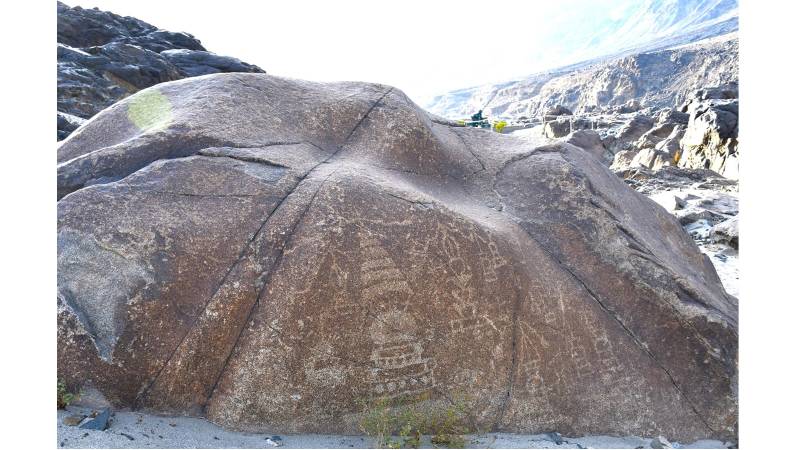
The Buddhist petroglyphs along the Indus River in Diamer district are some of the most fascinating sites to explore. I have been visiting these sites since 2000 when I worked as a consultant for IUCN. These petroglyphs, which include images of stupas, Buddha, and Bodhisattvas, can be found on the boulders and cliffs that overlook or face the Indus and the Karakoram Highway. For centuries, the Indus served as a route for traders, travellers, and pilgrims, all of whom left their marks in the form of rock engravings wherever the river flows and where suitable rock surfaces are found for creating these drawings.

There are several rock art sites that feature magnificent Buddhist images, but I will focus on the petroglyphs at the Chilas I rock art site. This site is located on the left side of the Indus River, above the Karakoram Highway and directly opposite the Thalpan Bridge. Here, a group of Buddhist petroglyphs can be found on the hillside. Professor Dr. Ahmad Hasan Dani discusses this site in his books Chilas: The City of Naga Parvat (Dyamar) and Human Records on the Karakorum Highway.

At first glance, one notices a Buddha figure seated on a lotus. As one continues to climb the hill, the most magnificent Buddhist engravings come into view on a cliff. The most prominent feature of the cliff is a panel that depicts two figures of Bodhisattvas. On the left is the figure of Bodhisattva Avalokiteshvara, while on the right is the image of Bodhisattva Maitreya. Next to this is a large stupa with a Brahmi inscription.
The most captivating depiction is the discussion between the two Bodhisattvas, Avalokiteshvara and Manju Sri. This boulder also features three large stupas
Another panel on a rock wall, visible from the KKH, features six engravings or images. Moving from left to right towards the KKH, the first image is of the seated Bodhisattva Avalokiteshvara. Next to this figure is an image of Buddha Sakyamuni. Following that, a large stupa is depicted alongside another figure of Buddha, with the stupa positioned between two representations of Buddhas.

Below the figure of Buddha is an image of the worshipper and donor Simhadeva. Professor Dr. Ahmad Hasan Dani believes that this figure represents King Simhadeva, who is shown seated, holding a rosary in one hand and a lamp in the other. On the left side of the Buddha and Simhadeva figures, there is an engraving of the standing Bodhisattva Maitreya, who holds a water pot in his hand.

This rock panel has been constantly vandalised. I initially visited this site in 2000 and subsequently returned in 2001, 2002, 2005, 2006, 2009, 2010, 2014, 2019, and 2022. Unfortunately, the Buddhist images at this location have frequently been subjected to vandalism. The images remained undamaged during my earlier visits in 2000, 2001, 2002, and 2006. However, during my visit in 2009, I observed a frieze of Buddhist images being defaced with white paint. Although some of these images were later cleaned and restored, the issue of vandalism has persisted. In 2019, Buddhist images were painted over again, but following considerable outcry from the local community and civil society, the paint was eventually removed from several figures. During my visit in 2022, I noted that the rock panel had once again been vandalised with paint, with only three images remaining intact.

The engravings of Bodhisattva Maitreya can be seen at other rock art sites in Chilas. In fact, the cult of Bodhisattva Maitreya was once widespread in the Upper Indus Valley. The remains of a particularly ancient and famous Buddhist monastery, locally known as Naukot, are located on a hill overlooking Phuguch village in the Darel Valley. The earliest information about this monastery comes from two Chinese pilgrims, Faxian (Fa-hsien) and Xuanzang (Hsuan-Tsang). Faxian (d 422) visited Darel around 403 AD on his journey to Udayana (Swat). During this journey, he described the monastery of Ta Li Lo, or Darel Valley, and noted the presence of a carved wooden image of the Bodhisattva Maitreya. Later, Xuanzang (d 664) also visited the Buddhist monastery in Ta Li Lo and acknowledged its significance as an old and important seat of the government of the Udayana Kingdom. Both pilgrims reported the presence of many monks, all students of the Hinayana school of Buddhism. Sir Aurel Stein (d 1943) visited Darel Valley during the rule of Pakhtun Wali Khan. He authored the book Innermost Asia Vol. 1, in which he documented the history and heritage of both Darel and Tangir valleys. Stein was the first European to record his observations of these regions.

One can also observe a carving of Boddhisatva Maitreya at the Thalpan rock art site. There is a large boulder at the Thalpan rock art site that depicts Sibi Jataka. The entire surface of the boulder is a canvas of carvings, each telling a unique story. According to Dr Ahmad Hassan Dani (1983), this boulder depicts Jataka stories of Buddha, notably Sibi Jataka, and the ascetic and animals. The most captivating depiction is the discussion between the two Bodhisattvas, Avalokiteshvara and Manju Sri. This boulder also features three large stupas. In between the two stupas is a carving of Sibi Jataka, which shows a standing Bodhisattva holding a balance in his hand. On his left is a seated king with a crown on his head, holding a dove in his left hand. The king receives flesh in his right hand from the Bodhisattva, who is taking his flesh from his left thigh with his left hand and presenting it to the king. Sibi Jataka is also engraved on a boulder at the Shatial rock art site in KP’s Upper Kohistan district, which I have visited several times en route to Darel Valley.

On the extreme right side of the boulder, there is an engraving depicting a sage who is feeding animals while seated beneath a tree. Adjacent to this, another engraving illustrates the seated Bodhisattva Maitreya, portrayed on a double-petaled lotus and accompanied by two scripts.
In addition to the figures of Buddhas and Bodhisattvas at the Chilas rock art site, several votive stupas can also be seen. One particularly impressive stupa depicts a devotee holding a rosary in one hand and an incense burner in the other.

Apart from the carvings on the hill, several stupa images are visible on boulders along the left bank of the Indus River. As one continues past this group of carvings that depict Buddhas, Bodhisattvas, and stupas, one will also notice more stupa images on the right side of the Karakoram Highway (KKH) and along the left bank of the Indus. One of the most remarkable carvings is a Jataka story portraying Buddha's self-sacrifice. This engraving, located on a boulder near the left bank of the Indus, shows the Buddha offering his body to a tigress unable to feed her cubs. To the left of this depiction of the Buddha sacrifice, there is a large stupa accompanied by a monk and an inscription.

